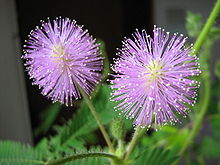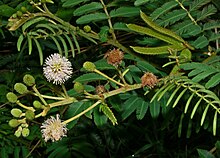Mimosa
| Mimosa | |
|---|---|

| |
| Mimosa flower heads | |
| Scientific classification | |
| Kingdom: | Plantae |
| Clade: | Tracheophytes |
| Clade: | Angiosperms |
| Clade: | Eudicots |
| Clade: | Rosids |
| Order: | Fabales |
| Family: | Fabaceae |
| Subfamily: | Caesalpinioideae |
| Clade: | Mimosoid clade |
| Genus: | Mimosa L. (1753) |
| Type species | |
| Mimosa pudica | |
| Species | |
| Synonyms[1] | |
| |
Mimosa is a genus of about 600[2] species of herbs and shrubs, in the mimosoid clade of the legume family Fabaceae. Species are native to the Americas, from North Dakota to northern Argentina, and to eastern Africa (Tanzania, Mozambique, and Madagascar) as well as the Indian subcontinent and Indochina.[1] The generic name is derived from the Greek word μῖμος (mimos), an "actor" or "mime", and the feminine suffix -osa, "resembling", suggesting its 'sensitive leaves' which seem to 'mimic conscious life'.[3][4]
Two species in the genus are especially notable. One is
Taxonomy
The taxonomy of the genus Mimosa has gone through several periods of
Description
Members of this genus are among the few plants capable of
Mimosa can be distinguished from the large related genera,
Species




There are about 590 species including:[6]
- Mimosa aculeaticarpa Ortega
- Mimosa andina Benth.
- Mimosa arenosa (Willd.) Poir.
- Mimosa asperata L.
- Mimosa borealis Gray
- Mimosa caesalpiniaefoliaBenth.
- Mimosa casta L.
- Mimosa cupica Gray
- Mimosa ceratonia L.
- Mimosa diplotricha C.Wright ex Sauvalle
- Mimosa disperma Barneby
- Mimosa distachya Cav.
- Mimosa dysocarpa Benth.
- Mimosa emoryana Benth.
- Mimosa grahamii Gray
- Mimosa hamata Willd.
- Mimosa hystricina (Small ex Britt. et Rose) B.L.Turner
- Mimosa invisa Martius ex Colla
- Mimosa latidens (Small) B.L. Turner
- Mimosa laxiflora Benth.
- Mimosa loxensis Barneby
- Mimosa malacophylla Gray
- Mimosa microphylla Dry.
- Mimosa nothacacia Barneby
- Mimosa nuttallii (DC.) B.L. Turner
- Mimosa ophthalmocentra Mart. ex Benth. 1865
- Mimosa pellita Kunth ex Willd.
- Mimosa pigra L.
- Mimosa polycarpa Kunth
- Mimosa pudica L.
- Mimosa quadrivalvis L.
- Mimosa quadrivalvis var. hystricina (Small) Barneby
- Mimosa quadrivalvis var. quadrivalvis L.
- Mimosa roemeriana Scheele
- Mimosa rubicaulis Lam.
- Mimosa rupertiana B.L. Turner
- Mimosa scabrella Benth.
- Mimosa schomburgkii Benth.
- Mimosa somnians Humb. & Bonpl. ex Willd.
- Mimosa strigillosa Torr. et Gray
- Mimosa tenuiflora (Willd.) Poir. (= Mimosa hostilis)
- Mimosa texana (Gray) Small
- Mimosa townsendii Barneby
- Mimosa turneri Barneby
- Mimosa verrucosa Benth.
References
- ^ a b "Mimosa L." Plants of the World Online. Royal Botanic Gardens, Kew. Retrieved 6 September 2023.
- ^ "Caesalpinoideae". Legume Data Portal. Retrieved 9 September 2023.
- ISBN 978-0-521-86645-3.
- ISBN 9780203491881.
- ^ Neuroscience; Bear, Connors, Paradiso
- ^ "Mimosa L." Plants of the World Online. Royal Botanic Gardens, Kew. Retrieved 31 August 2022.
